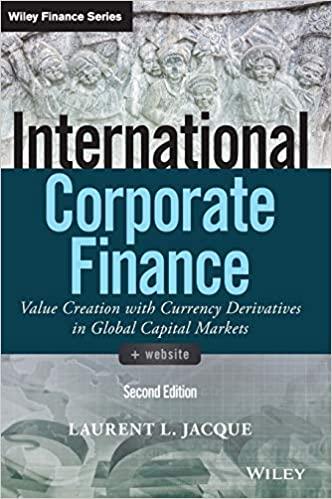Fuji Life Insurance Co. global money management (advanced). Hiko Yamamoto, the deputy treasurer of Fuji Life Insurance
Question:
Fuji Life Insurance Co. global money management (advanced). Hiko Yamamoto, the deputy treasurer of Fuji Life Insurance Co. (FLI), was reviewing one-year investment opportunities for the 100 billion yen of cash balances. As interest rates were becoming negligible in Japan at 0. 50 percent on one-year yen-denominated treasury bills, Hiko was seriously considering euro notes issued by the Dutch government and offering a yield of 3. 25 percent when the attractive yield on zero Uridashi one-year zero-coupon bonds (UAZ) denominated in Australian dollars (AUD) caught his eye.
a. Assuming that UAZ are currently priced at 95 percent, what is the forward yen (¥) price of one Australian dollar for one-year maturity? Be explicit about your assumptions; ¥100 = AUD 1. Hint: Compute the one-year interest rate on UAZ first.
b. Assuming the forward rate is ¥97 = AUD 1 and one-year borrowing cost in Japan for FLI is 65 basis points, show how Hiko could set profitable arbitrage opportunities between ¥ and AUD. Would your answer be different if the tax rate
(40 percent) on interest income is twice the tax rate (20 percent) on forex gains?
c. Hiro, Hiko’s first cousin, is the procurement manager for the specialty steel division of Mitsubishi Heavy Industries (MHI). Having just contracted for the imports of iron ore from Australia in the amount of AUD 100 million payable in 360 days, Hiro is advised by his cousin Hiko to consider using UAZ for hedging currency risk on behalf of MHI. What is your advice to Hiro?
d. Would you classify UAZ as samurai bonds or euro-yen bonds? Should Japan’s Ministry of Finance ban them?
Samurai bonds are yen-denominated bonds issued in Japan by firms domiciled abroad. UAZ are foreign currency bonds for sale in Japan. According to the Wall Street Journal (March 7, 2003), Japanese investors were gobbling up Australian dollar–denominated offerings, purchasing a total amount of AUD 8 billion in 2002 and close to AUD 5 billion in the first two months of 2003.
Step by Step Answer:

International Corporate Finance Value Creation With Currency Derivatives In Global Capital Markets
ISBN: 9781119550464
2nd Edition
Authors: Laurent L. Jacque





